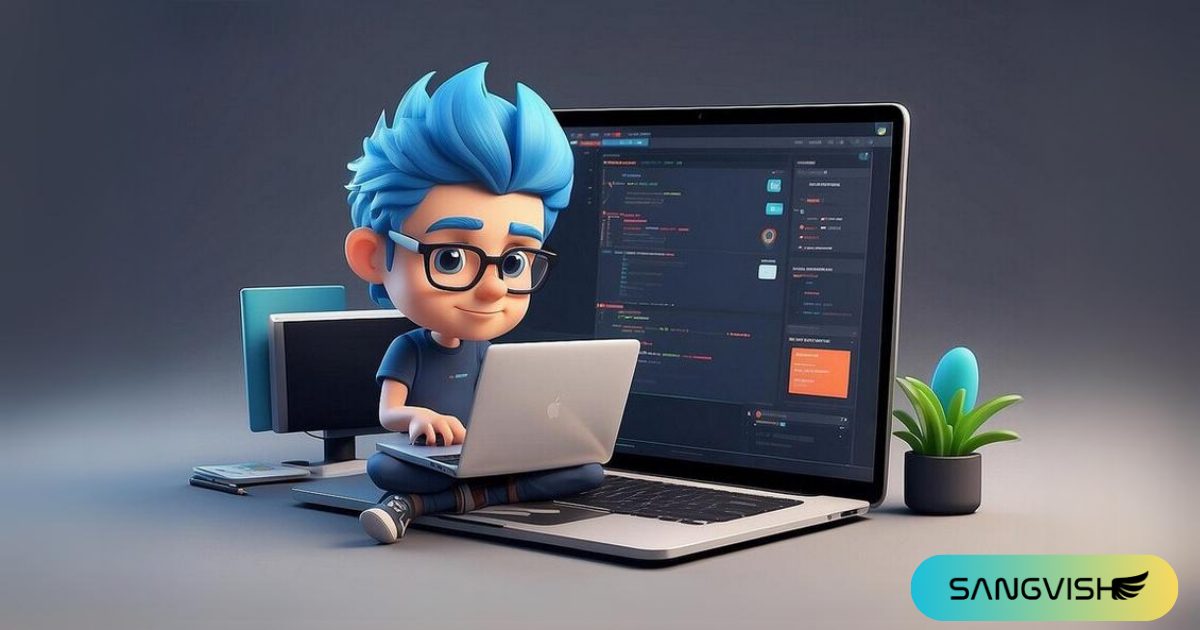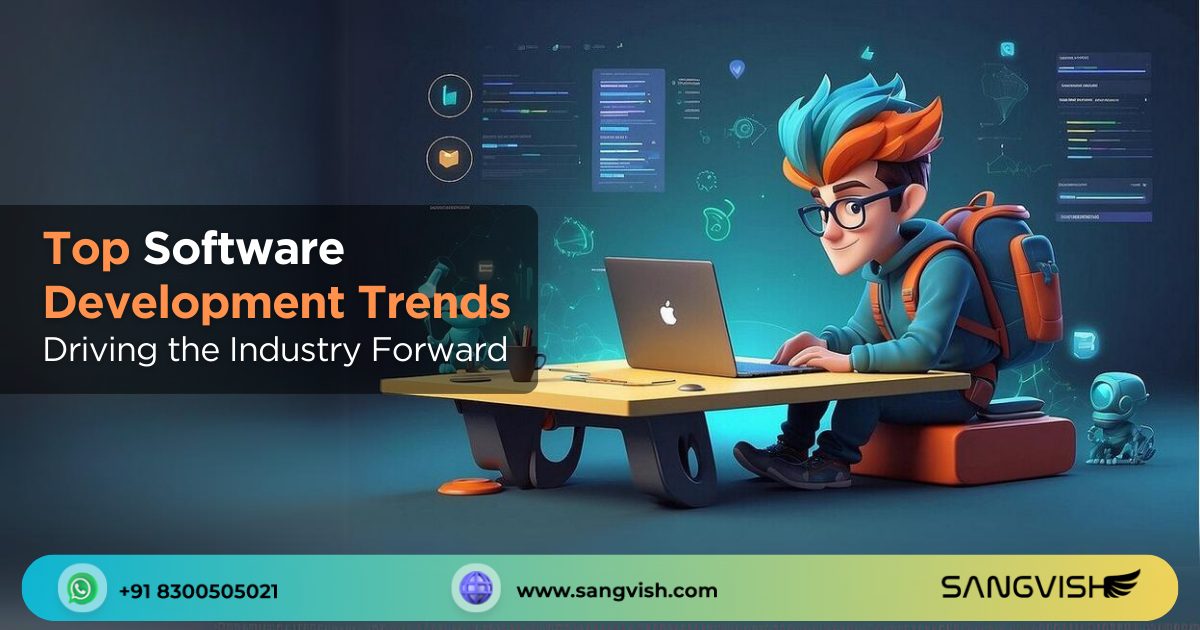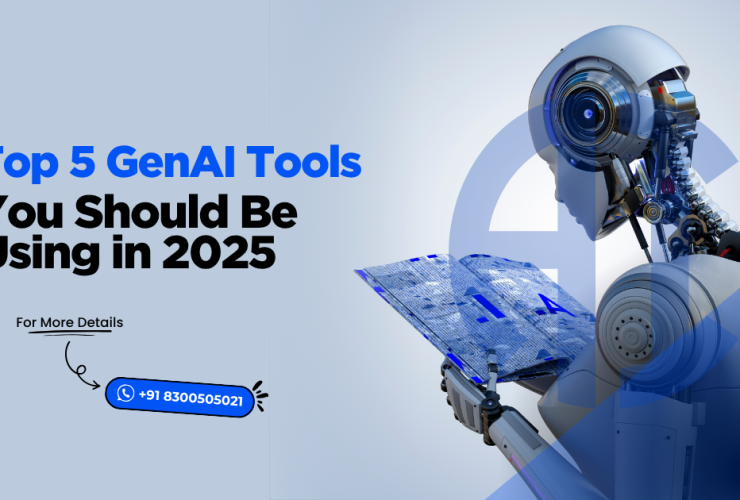Hey there, tech enthusiasts! Are you really curious about what comes up in the world of software development, then you’re in the right place.
Software development has become a major part of our latest modern world, it operates everything from smartphones to multipart business systems. This rapid growth of technology is constantly increasing, and it also impacts the software development industry.
According to a recent report, the industry has seen incredible growth with worldwide software spending projected to reach $650 billion by 2025, reflecting a 7% annual growth rate.
To stay ahead in the industry growth, it is more significant to know about the top software development trends which will shape the future in the industry.
This blog post will explore the key software development trends leading the industry forward. From the growth of low code development which is expected to get 65% of app development by 2024 to the taking up of artificial intelligence and machine learning which is expected to add around $15 trillion to the global economy by 2030, and also these trends will transform the way we build and deploy the apps.
We will also let you know how these trends will be helpful for the future growth of businesses of all sizes, from startups to established businesses.
If you are an experienced software developer or an individual looking to know about the latest technological trends, this post will offer you valuable insights that let the industry grow.
Explore the 10 Leading Software Development Trends
Let’s get into the key software development trends in 2024 that are reshaping the software environment. These trends reflect the industry’s response to technological improvements, transforming user demands, and global challenges.
1. Artificial Intelligence (AI) and Machine Learning (ML) 🤖
Artificial Intelligence (AI) is everything about making machines that can think and learn like humans. Think of computers that can realize, and make decisions on its own knowledge. Machine learning is the subsection of AI, where the machines learn more from the data and enhance over time without being particularly programmed to do the task.
Benefits of AI and MI
🤖 Enhanced Personalization: By analyzing user preference and their behavior, AI and ML enable more personalized user experiences.
🤖 Automation: It also streamlines repetitive tasks and decision-making processes, which improves efficiency and reduces human error.
🤖 Advanced Analytics: Using AI, you can dig deep into data to uncover insights and make predictions that guide your next big move.
Future of Artificial Intelligence (AI) and Machine Learning (ML)
The future growth of Artificial Intelligence and Machine Learning is more exciting. It will be enhanced with even smarter algorithms, more innovative applications and deeper personalization. You can expect AI to become a major part of our day to day tech experiences.
2. Cloud Computing ☁️
Cloud computing is a robust computer and storage system available over the internet. Instead of investing and maintaining your own servers, you can use cloud resources, which can be accessible and manage the data from anywhere.
Why Cloud Computing is Awesome
☁️ Flexible Scaling: The cloud can be tailored to your business demands, so you never need to worry about storage overloading.
☁️ Cost Savings: When using cloud computing, you only pay for what you use. You don’t need to spend more on hardware.
☁️ Team Collaboration: Cloud platforms make it easier for team members to work together remotely in real-time.
Future of Cloud Computing
The cloud computing market is predicted to rise with more enhancements in the technology and it can be accepted by all kind of organization. It is expected that in feature the cloud services will include other services, enhanced security and optimal compatibility with other futuristic technologies.
3. Edge Computing 🌐
Edge computing is a decentralized model designed to enable computation and store the data where it is needed. In edge computation, data is processed at the actual location or edge network or closer network.
Advantages of Edge Computing
🌐 Speedy Performance: By processing the data from its closer source you can get a faster response, which is more important in real time applications.
🌐 Bandwidth Saving: Edge computing reduces the need for large data transfers and optimizes your network performance by managing the data locally.
🌐 Improved Security: By keeping the data close to where it is generated, it gets less exposure from data breaches.
Future of Edge Computing
As the number of connected devices increases, the edge computing will become even more significant. So, in future, we can expect smarter edge devices and more seamless integration with cloud services.
4. DevOps and Continuous Integration/Continuous Deployment (CI/CD) ♾️
DevOps is a set of rules, practices, activities, culture, and set of designed tools to burst the traditional soils between Dev (development) and Ops (operations) teams. Through automation, collaboration, and shared work for the full software lifecycle, DevOps’s goals are to deliver software more quickly, with small bugs, and with the biggest flexibility.
The Major Role of CI/CD in DevOps
CI/CD is an important component of the DevOps working process, automating the steps needed to integrate code modifications and deploy them into environments of production.
Continuous integration(CI)
The continuous integration concept implies a constant integration of code changes into a common repository. Each integration is then automatically tested to protect and address bugs as early as possible.
The Advantages of Adopting DevOps and CI/CD
Adopting DevOps and CI/CD provides multiple advantages, including:
♾️ Quality and Reliability: CI and CT will help to find the bugs easily and solve them early, leading to more reliable and stable software.
♾️ Fast and Efficiency: Automated testing and development processes support companies to introduce software updates more easily and quickly, giving them more efficient software to get returns and stand out in the market.
♾️ Customer Satisfaction: Faster release cycles involve clients getting new innovative features and developments more often, leading to huge levels of satisfaction.
♾️ Collaboration and Communication: DevOps promotes a culture of shared work, bursts the walls between groups, and fosters effective collaborations.
Future of DevOps and CI/CD
The future of DevOps will involve improving dynamics like advancements in AI, cloud technologies, and automation. Companies will strive for quicker, more comfortable delivery of reliable software.
The development of containerisation and microservices will further continuous deployment processes and integration, fostering a more scalable and resilient infrastructure.
5. Blockchain Technology ⛓
Blockchain is a large distributed ledger that helps to record all data and transaction information transparently and securely. The blockchain is a chain of blocks, each block is connected to the before and after blocks. This helps to protect the data. No one can modify, delete, or change the blocks. Most companies use blockchain technologies to protect their information.
Types of blockchains:
There are four types of blockchain technologies available, these are
1. Public blockchain
A public blockchain is a decentralized network, anyone can work anywhere, and access the blockchains, and transactions. The decentralized or public blockchains best examples are Ethereum and Bitcoin.
2. Private Blockchain
A private blockchain is a protective and restricted network, so selected persons only access the blocks and specific places. Many organizations use this private blockchain.
3. Consortium Blockchain
A Consortium Blockchain is a combination of blockchains, a hybrid between public and private blockchains. This consortium blockchain is used by governed by a group of companies rather than one entity.
4. Hybrid Blockchain
A Hybrid Blockchain is a federation of both private and public blockchains. This hybrid blockchain supports companies that can have a private blockchain for specific data and important data and a public blockchain for general permission systematic works.
The Benefits of Blockchain Technology
Adopting blockchain technology offers several advantages:
⛓ Improved Transparency: All transactions are stored on a public ledger to make it safe and secure, it can be visible and not changeable for all participants.
⛓ Increased Efficiency: All are stored and recorded automatically by working processes such as smart contracts, which help to reduce manual interventions, time, and operations.
⛓ Enhanced Security: Blockchain’s cryptographic nature is to secure all data and information.
⛓ Reduced Costs: By eliminating intermediaries, blockchain can lower the cost of operational and transaction fees.
Future of Blockchain Technology
Blockchain technology will improve many fields such as healthcare, supply chain, cryptocurrencies, gaming, and real estate, it will be expanded in multiple sectors. Blockchain will improve integration with AI and IoT, transparency, and many more.

6. Internet of Things (IoT) 🦾
The (IoT) Internet of Things means the network of physical devices, from household appliances to industrial devices, that are interconnected to the network. It helps to exchange, act, and collect data. These devices are connected and act with software, technologies, and sensors, and with a centralized system to communicate with others. It permits a wide range of services and applications.
The Benefits of IoT
The many benefits of IoT are below here:
🦾 Budget-Friendly: By offering real-time information and predictable information, IoT assists in lowering operational costs and time and improves resource management.
🦾 Improved Efficiency: IoT devices automate all tasks and customize the processes, to improve productivity and efficiency.
🦾 Improved Quality of Life: The Internet of Things confirms the quality and convenience of life by offering personalized experiences and permitting smart environments.
🦾 Enhanced Safety: The Internet of Things increases safety via automation, monitoring, and in many places like workplaces, homes, and even public spaces.
Future of IOT
The future of the Internet of Things (IoT) will be smart to connect all devices that can easily monitor and control in one hand seamlessly and quickly. IoT technology advancements will save the time and cost of investment in mechanics and simplify all daily life and industrial processes. IoT helps to check the device via the internet in real-time and quickly make a decision.
7. Low-Code/No-Code Development ⚙️
Low-code and No-Code development systems have changed the way software is developed. It allows users to create an application with minimum or without coding knowledge. These kinds of platforms utilize user-friendly interfaces and ready-made components to simplify the process of development.
Why It Matters:
⚙️ Speed: Users can simply drag and drop the components instead of writing lengthy coding, which also helps to decrease the development time.
⚙️ Accessibility: Users without technical backgrounds can take part in the application creation process. Also, making it easier to enable more interaction across sections.
⚙️ Cost Efficiency: It lowers the cost and needs for skilled developers, which makes technology more affordable to new startups and small-scale businesses.
⚙️ Increased Flexibility: It allows business owners to immediately adapt to the changing needs and circumstances in the market without depending mainly on IT departments.
Impact
Low-code/No-Code platforms speed up developments by enabling firms to rapidly adapt to changes and test new ideas with higher adaptability.
8. Cyber Security 🔐
Software becomes a more essential part of each business and daily lives cybersecurity also has the highest priority. Cybersecurity is the activity of securing systems, networks, and data from digital threats, theft, or destruction. With the growing threats and advanced crimes, maintaining the safety of software applications is essential. Modern software development techniques must implement strong safety measures from the beginning.
Key Practices of Cyber Security
🔐 Secure Coding Practices: Software developers are highly adopting safe coding techniques to avoid issues.
🔐 Regular Security Audits: Doing regular security inspections and evaluations assists to spot and fix possible threats.
🔐 Threat Intelligence: Utilizing threat intelligence may offer information about new threats and improve active security measures.
Importance
Implementing cybersecurity into the entire software development process secures sensitive data, keeps trust among users, and guarantees regulatory requirements.
9. Agile Methodology and Scrum Framework
Agile methodology is the adaptable method to software development that focuses on gradual progress, cooperation, and being responsive to change. Rather than a strict linear development process, Agile prioritizes providing tiny, incrementally updates that correlate with user requirements and feedback.
Scrum framework is the well-known methodology of agile which assembles work into time-boxed phases known as sprints. Every sprint is generally 2-4 weeks long and contains planning, creation, testing and examination.
These methods encourage constant enhancements, user feedback and timely delivery of usable software.
Key Concepts of Agile Methodology and Scrum Framework
➡ Iterative Development: Agile focuses on providing software in tiny, easily manageable stages, it allows for regular modifications based on feedback.
➡ Cross-Functional Teams: Scrum encourages cooperation between various team members, such as developers, designers, and stakeholders.
➡ Regular Sprints: Scrum allocates work into sprints, or time-boxed phases, to meet particular goals and deliverables.
Benefits:
🔄 Flexibility: Agile and scrum enable teams to quickly adapt to changing demands and targets, making sure the end outcome is strongly aligned with client needs.
🔄 Transparency: Routine reviews and updates increase transparency and guarantee proper alignment with client requirements.
🔄 Efficiency: Continuous development and frequent feedback repeats enhance the product’s effectiveness and quality.
Implementation
Agile and Scrum are suited for several types of assignments, from complicated apps to lower, more concentrated tasks. Their versatility makes them extremely useful for teams seeking to improve their process of development and results.
10. Quantum Computing ⚛
Quantum Computing is described as next-gen computation power. It uses quantum mechanics which can’t be understood by human knowledge, to solve complex problems in a faster way than traditional computers ever could.
Benefits
⚛ Lightning-Fast Problem Solving: Quantum computers can handle the problems that are most difficult for traditional computers, like cryptography and complex models.
⚛ Incredible Processing Power: Quantum bits (qubits) allow for processing huge amounts of information simultaneously, which unlocks new possibilities in computation.
⚛ Future Innovations: As quantum technology advances, it will drive revolutionary innovations in various fields.
Future of Quantum Computing
While quantum computation is still in the early stages, it is on track to make huge steps. We’ll see more real time applications and significant steps forward as the technology grows.
Conclusion
In the final notes, Fastly growing in the fast-developing world of software development needs the most important and top trends to shape the business.
The rise of AI/Mi is improving, and advancements in DevOps and CI/CD are more unique. It helps to transform the software with high quality, scalability, user experience, and more.
Many popular and best software development trends are explained, and its future will help you to understand the trends of the business and market to develop your business and stand out from competitors to meet your business’s future demands.




